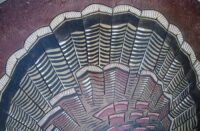
In this business we are used to fixing our own mistakes. However, we are sometimes required to fix another installer’s decorative concrete mistake. This can be an uncomfortable experience for all involved. It is important to be sensitive to the client’s fears, insecurities and possible anger. It is also important to be sensitive to the fact that money has been paid out to the other installer and that good money will have to be paid out after bad. Last but not least, it is important not to bad-mouth the other installer’s work, as this will be a bad reflection on you and do no good for the situation as a whole.
Recently, we were called by a homeowner who had asked us to bid on his project a year earlier. He had decided to use his painter, who had given him a lower price to do his floors. Upon going to his home and looking at his floors, we sat down with him and asked him to give us as much information as he could on what was done in the installation of his floor finish. We then asked to speak to the installer of the floor to get any other forensic information we could gather. At this point we spoke to the manufacturer’s rep regarding the products that were put down and got those spec sheets sent to us.
Once we had all of the information we could get regarding this failure, we sat down and analyzed it so we could get a game plan of how we could fix the problem. We structured our proposal to the homeowner in a way that gave him choices for how far he wanted to go to get his floors fixed. This way the client did not feel backed into a corner. These choices were not only based upon scope of work, but price and the potential longevity of the products we were bringing to the table.
In this case, we had a new concrete foundation that was acid-washed and then stained with an acid-based stain, a problem that happens way too often. The stain did not take due to the acid reaction that precluded the acid stain application. This floor was then sealed with a water-based acrylic sealer, which compounded the problem because it did not enhance whatever reaction did take place when the floor was stained. The owner was not at all happy with the results, so the installer then used a water-based tinted sealer to color the floor. That product never bonded with the already sealed floor and within days, the floor started peeling and scratching.
After careful consideration and discussions with the owner in regards to his needs, we came up with a plan of action. He did not want to remove the wood base molding, and had finished cabinets and stainless built-in appliances. We pre-scraped off all the finish that we could and then proceeded to buff and sand the floor using a soy-based product that would not harm any of the finishes we were working around. We then acid-stained the concrete using enhancers and sealed the stained concrete with a solvent-based sealer to enhance the acid stain color.
The floors turned out beautiful, the owner was happy, there was no residual damage left from our stripping the floors and within a short amount of time, the whole situation will be but a distant memory. From our standpoint, there is real satisfaction in taking a problem that seems to have no solution and turning it around to a positive. Isn’t that what problems are all about?















